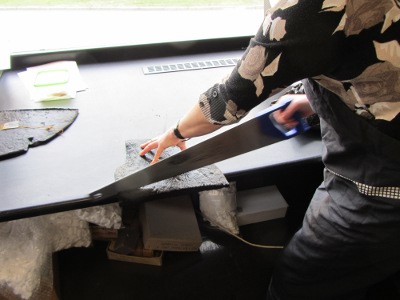Dendrochronology and provenance determination
Dendrochronology or tree-ring dating is the method by which timbers are precisely dated through measurement and analysis of the trees’ ring width. The variation in the tree-ring width, influenced by the annual climate variation during the trees’ growth, is the code used in dendrochronology. By comparing the pattern of wide and narrow rings from a timber of unknown age with tree-ring chronologies from Northern Europe, the precise chronological position of the measured tree-ring series from the timber can be found. As the position of these chronologies is precisely dated by linking them with tree-ring data from living trees, an accurate date for the timber can be given. If bark or bark edge is preserved on the sample or object, the dating for the felling of the tree is accurately dated.

As the tree-ring variation in the timber is a record of the climate affecting the tree in the region where the tree was growing, this information is also used by me to identify this region. This method is of particular importance to our study of the human past, when analysing shipwrecks, barrels, painted panels and artistic or eccliastical sculpture, as these particular objects were widely transported and traded. However, analysing the region of origin of timber from structures on land is also showing us the extent of traded timber through time. Some regions in Northern Europe at various times over-exhausted their native timber ressource, and needed to import timber from regions that had surplus. Using my provenance determination technique the chronology, geography and extent of the trade in building timber in Northern Europe is increasingly emerging.
How to sample for dendrochronological analysis
Dendrochronological analysis can be carried out on both waterlogged, dried and preserved wood. A slice of the timber should be sawn for dendrochronological study. For oak, look for sapwood and/or bark on the timber. If there is bark on the sampled timber the precise felling year can be determined. If there is sapwood preserved the felling date will be indicated with high accuracy. Sapwood sits just under the bark and forms the outer approx. 20 growth rings of a living tree. It can be seen as a lighter area along the outer edge and can be very soft. There must therefore be exercised great care in the selection of the sample, so that the outer rings of the tree are unharmed. Make sure the sample is taken at the place where there is sapwood and no knots. When the disc is sawn, then look at the growth rings. The best dendro-sample is at the place where the tree has grown regular, without distortion. If growth rings are irregular, so cut a slice further along the timber if possible. It is best to take the dendro sample through the place where the bark or bark edge is preserved. A disc approx. 2 cm in thickness should be cut through the entire tree. If the wood is fragile, a thicker slice can be taken, so there is no danger of the material falling apart. It is not a problem that the disc breaks - the parts can usually still be used.
Count the annual rings
It is not the wood / timber dimensions, but the number of growth rings in each sample, which is crucial for successful dating. The best chance for a good result is obtained with samples of approx. 100 years. The probability of dating samples with less than 100 years decreases the fewer rings there are. Samples with fewer than 60 rings are less suitable for dendrochronological analyses however, if there are individual samples with few growth rings among samples from the same structure, it can be possible. What matters is not the size of the timber, but the number of rings. A barrel stave, for example, can be made of wood with very narrow regular rings. Felling date and area of origin of wood from many archaeological finds of barrels has been successfully determined.
Waterlogged wood
It is best to take samples from waterlogged wood by cutting slices using a saw. Wrap the sample in clingfilm to seal the water and prevent drying out. Put it then in ziplock bag or similar, and label clearly. Always make it clear whether the samples are to stay waterlogged to be returned for conservation, or whether they can be allowed to slowly dry out after analysis, for archiving. Contact me.
Dry wood
Samples from dry timber (eg. in historic buildings, church furniture etc..) are usually taken by coring, so that it is only necessary to make a small intervention in the wood. Dendrochronologists have several kinds of corers for the purpose, and usually do the sampling. Contact me.
Minimal damage
Certain objects can be analysed with minimal damage. This is particularly applicable to fine-art paintings on wooden panels, church sculpture, and certain archaeological material. By paring carefully at the exposed end-grain of a plank, or on the base of a sculpture, and taking measurements of the tree-rings thus made clearly visible, no sawing or coring is necessary. Contact me.
Non-destructive analysis
Recent research by me and my research collaborators Jan Bill (Oslo University) and Øistein Johnsen (Norwegian Geotechnical Institute) has enabled the development of a non-destructive dendrochronological analysis technique. It entails CT scanning of the wooden objects, but there are limits to the size of object that can be scanned, and is costly. Contact me.

